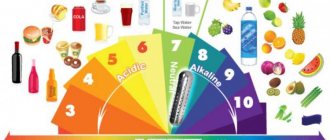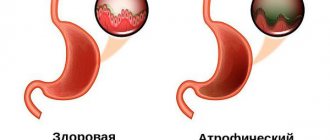Stomach problems are one of the most common ailments that plague a huge number of people. Sometimes it is severe pain, sometimes constant nausea, and often vomiting and lack of appetite. There are many reasons for the occurrence of such problems, but one of the main reasons why a person feels discomfort is increased stomach acidity; you can learn more about the symptoms of this pathology.
Causes
Increased stomach acidity can provoke the development of severe pain syndrome
Before moving on to the main symptoms of increased stomach acidity, it is worth saying what gastric juice is and why pathology can develop. Gastric juice is the juice that is produced by various cells of the mucous membrane of this organ. Thanks to this juice, the normal digestion process occurs and the necessary nutrients are absorbed in the body. One of the main indicators of normal stomach function will be the concentration of acid in gastric juice. Very often people experience increased acidity, which can be caused by the following reasons:
- Poor nutrition. Abuse of alcohol, spicy and fatty foods, large amounts of food consumed or, conversely, irregular meals in small portions
- Poor chewing of food. Often, when a person eats in a hurry, many large unchewed pieces of food end up in the stomach, which are very difficult to digest. And in order to do this, the stomach is forced to produce more gastric juice, and as a result, increase its acidity
- Long-term use of certain medications that have a harmful effect on the gastric mucosa. Such drugs usually include paracetamol, aspirin, hormonal medications, analgin
- Stress. Severe emotional overload, as well as constant tension, can provoke the development of various health problems in a person. Very often, the first thing this affects is the gastrointestinal tract, since in most cases, when experiencing stress, a person forgets to eat, or takes a large amount of alcoholic beverages, which have a detrimental effect on the gastric mucosa
- Smoking. Tobacco smoke, despite the fact that it is most concentrated in the lungs, negatively affects the normal functioning of the stomach. Smokers often have digestive problems. Tobacco smoke causes the greatest harm when a person smokes on an empty stomach. It is at this moment that toxic substances have the greatest effect on the mucous membrane, provoking increased secretion of gastric juice and an increase in its acidity
- Helicobacter. More recently, scientists discovered this bacterium, which is the cause of such diseases. Like stomach ulcers and gastritis. Helicobacter is one of the few bacteria that, due to its good adaptive abilities, can live in the stomach. If it enters the body, specific enzymes will be produced that damage the gastric mucosa. Separately, it should be noted that this bacterium is transmitted through saliva. Therefore, it is easy to become infected with gastritis by drinking from the same cup with someone who has it.
- Infection. After a person has suffered an infectious disease, be it even a simple influenza virus, complications may arise that sometimes affect the gastric mucosa. Any infection can spread very quickly throughout the body and find a further place for development in absolutely any organ.
Despite the fact that almost every person knows the main reasons why gastritis can develop and the content of hydrochloric acid in the gastric juice can increase, few people pay attention to them until the problem hits them.
Treatment
Information on how to reduce stomach acidity should be obtained from a gastroenterologist. Any options for self-medication at home using improvised means are not only ineffective, but can also lead to the development of complications. For symptoms of gastritis with high acidity, diet and treatment include exclusion from the diet of fried and fatty foods, smoked meats, fast food, alcohol, canned meat, fish and vegetables, spices, seasonings, and sauces. You should eat in small portions, 4-5 times a day. Dishes must be prepared mainly by steaming or boiling. In case of increased acidity of the stomach, diet No. 1 according to Pevzner is prescribed.
For symptoms of gastritis with low acidity, treatment and diet include recipes for dishes that stimulate the acid-forming function of the stomach.
To treat high stomach acidity, traditional medicine uses the following groups of pharmaceuticals:
- Antibacterial drugs that are effective for hyperacid gastritis caused by the bacterium Helicobacter pylori.
- Enveloping agents.
- Proton pump inhibitors.
- Antacids.
- H2 histamine blockers.
- Bismuth preparations.
To maintain normal gastric acidity, it is important to maintain a balance of normal gastric microflora. For this purpose, it is recommended to use metaprebiotics, which contain a natural nutrient substrate for gastric and intestinal bacteria. Metaprebiotic Stimbifid Plus helps not only restore the balance of normal gastric and intestinal microbiota, but also promotes the eradication (destruction) of Helicobacter pylori. Also, metaprebiotic components accelerate the process of restoration of the gastric epithelium.
Main symptoms
Increased acidity very often occurs against the background of an imbalance in the process of regulating the acidity of the juice, as well as its neutralization. That is why a person may experience the following symptoms:
- Heartburn. It usually occurs either immediately after eating, or at the moment when a person takes a lying position. Heartburn is the reflux of stomach acid into the esophagus. The juice irritates the mucous membrane and therefore a strong burning sensation occurs, which is localized mainly in the Adam's apple area
- Belching, which usually tastes either sour or bitter. Moreover, it appears mainly after eating
- Pain. It can be either strong or not very strong. It occurs at the moment when acid enters the duodenum, or rather into its lumen. In addition, another cause of pain will be acid getting into damaged mucous areas. At the moment when their interaction occurs, the person feels a strong pain attack, which can last for several minutes. At the same time, it is difficult for a person to even move, the pain is so severe
- Feeling of heaviness. This usually happens even after a small meal or snack.
- Bloating
- Problems with stool. In some people this may be diarrhea, which is very difficult to relieve even with medications, and in some people it may be constipation for a long time.
- Problems with appetite. Due to the fact that after each meal a person suffers from pain or heartburn, appetite gradually decreases
- State of apathy, bad mood
- A feeling of constant discomfort in the stomach area, which can be manifested by stretching. Heaviness, tingling, etc.
And the most important thing is that not a single person has yet managed to relieve the symptoms on their own. Of course, there are several medications that can help temporarily alleviate the condition. But only a specialist can find out the true cause and prescribe treatment.
Gastritis
Proper nutrition - prevention of high stomach acidity
One of the most common reasons why a person may have increased gastric acidity is gastritis. Almost half of the world's people suffer from this disease. Gastritis is an inflammation of the stomach lining, which leads to symptoms such as belching, heartburn, pain during and before meals, etc. As a rule, with this disease, it is the inner mucous membrane of the stomach that is most damaged, which performs two very important actions - it produces gastric juice and produces protective mucus.
When a person is diagnosed with gastritis, it is most often accompanied by increased acidity of gastric juice, since it is the department responsible for its normal production that is affected and damaged. Therefore, if a person is diagnosed with gastritis, he is forced to take tests to check the acidity of gastric juice. Increased acidity of juice during gastritis is quite normal. True, a person with such a diagnosis needs to start treatment as soon as possible, before the stomach “digests itself.”
What symptoms will help to suspect a violation of stomach acidity?
High acidity is characterized by: heartburn, pain “in the pit of the stomach”, in the right hypochondrium, the nature of the pain can be different (aching, paroxysmal), sour belching, burning in the throat and chest, white coating on the tongue. Later symptoms: constipation, intestinal colic.
Low acidity is characterized by: putrid odor, rotten egg belching, metallic taste, diarrhea and constipation, decreased intestinal motility, flatulence, the presence of undigested food residues in the feces. In addition, with low acidity, the absorption of vitamins and minerals and protein digestion are impaired. Which in turn is manifested by acne, brittle hair and nails, decreased hemoglobin, lethargy, decreased stamina, and the frequent occurrence of fungal and parasitic diseases.
However, it is impossible to judge only on the basis of the patient’s feelings about the presence of a violation of the level of acidity in the stomach. To make a correct diagnosis, a person must undergo an examination.
Prevention
Regarding preventive measures, one thing can be said that they all come from the causes of this problem. Thus, preventive measures include:
- Proper nutrition, eating foods rich in fiber, proteins and vitamins
- Balanced nutrition, that is, eating small portions
- Avoiding fatty and spicy foods
- Exclusion from the diet of any fast foods
- Avoiding alcoholic beverages or drinking them in reasonable quantities
- Regular examination for the presence of Helicobacter bacteria, which provokes the development of many diseases
- Avoiding stressful situations
- Timely treatment of any infectious diseases, as they can cause complications
If you nevertheless discover at least one of the above symptoms, then you should not waste time and try to cure this disease yourself. Time will be wasted, and there will be no positive result, will there be temporary relief. Only a doctor can make an accurate diagnosis based on research and prescribe treatment. It will take a long time to treat high acidity, but it is worth making every effort and completing the full course of treatment, since this gap will not disappear on its own!
Stomach acidity
Stomach acidity
(
acidity of gastric juice
) - a characteristic of the concentration of acid in the lumen of the stomach or in gastric juice.
Measured in units of pH
.
Content
- Hydrochloric acid and the stomach
- Production and neutralization of stomach acid
- Stomach acidity values
- Acidity at various points in the stomach
- Methods for determining stomach acidity
- Assessment of acid formation and acid neutralization of the stomach by acidity level
- Increased stomach acidity. Symptoms
- Reduced stomach acidity. Symptoms
- Publications for healthcare professionals regarding stomach acidity
- Video for healthcare professionals
Hydrochloric acid and the stomach
The main contribution to the total acidity of gastric juice is made by hydrochloric acid, which is produced by the parietal (lining) cells of the fundic glands of the stomach, located mainly in the area of the fundus and body of the stomach.
The concentration of hydrochloric acid secreted by parietal cells is the same and equal to 160 mmol/l, but the acidity of the secreted gastric juice varies due to changes in the number of functioning parietal cells and neutralization of hydrochloric acid by alkaline components of gastric juice. The presence of other acids in the stomach of a healthy person is insignificant. Sometimes the stomach contains lactic acid, which is the result of the vital activity of lactic acid bacteria (lactobacteria, enterococci, lactococcus lactis, etc.), which can only exist in the absence of hydrochloric acid. The presence of lactic acid in the stomach indicates a significantly reduced acidity of the stomach or a complete absence of hydrochloric acid secretion. Most often, lactic acid is found in the gastric contents of stomach cancer. To correctly assess the condition of the gastrointestinal tract, the acidity value must be determined simultaneously in different parts of the stomach or in different parts of the esophagus, stomach and duodenum. For correct diagnosis of diseases, it is important to have information about the graph of changes in acidity over time (pH-gram) and the dynamics of changes in acidity after taking certain stimulants or medications.
Production and neutralization of stomach acid
One of the main functions of the gastrointestinal tract is secretory, ensuring the production and secretion by glandular cells of digestive juices containing enzymes and factors that contribute to their activation.
For the normal course of gastric digestion processes, a rhythmic release of hydrochloric acid into the lumen of the stomach is necessary. The constant secretion of hydrochloric acid provides the conditions for the proteolytic action produced by the main (another name for zymogenic) cells of the gastric mucosa - pepsin, denatures proteins, and provides a bactericidal effect. The gastric mucosa is divided into 2 main zones: a zone that produces hydrochloric acid, and a zone that secretes bicarbonates intended to neutralize hydrochloric acid.
The acid-forming zone is located at the level of the anatomical body and the cardiac part of the stomach. In this zone there is a large number of parietal cells (in men - from 960 to 1,260 million cells, in women - from 690 to 910 million) that produce hydrochloric acid.
The gastric mucosa contains a large number of endocrine cells that produce a number of hormones. 35% of endocrine cells in the stomach of a healthy person are enterochromaffin-like (ECL-) cells that secrete histamine, 26% are G-cells that secrete gastrin. In third place in number are D-cells that secrete somatostatin. Gastrin, histamine and acetylcholine stimulate the production of hydrochloric acid, somatostatin and prostaglandins inhibit it.
Accessory cells of the gastric mucosa secrete protective mucus with an alkaline reaction. Mucus keeps intact the entire array of gastric cells that come into contact with aggressive gastric contents. If the production of protective mucus is disrupted, destroyed or in relatively insufficient quantities, the aggressive gastric environment has a detrimental effect on the gastric mucosa, causing inflammation - gastritis, or leading to ulcers in the stomach and duodenum.
Thus, the stomach is a complex system containing both aggressive and defensive factors. Violation of their interaction leads to various pathological conditions, which can be called stomach diseases. The best method for elucidating the relationship between these factors is multichannel intragastric pH-metry (V.A. Stupin).
Stomach acidity values
The maximum observed acidity in the stomach is 0.86 pH, which corresponds to an acid production of 160 mmol/l.
The minimum acidity in the stomach is 8.3 pH, which corresponds to the acidity of a saturated solution of HCO3- ions. Normal acidity in the lumen of the body of the stomach on an empty stomach is 1.5–2.0 pH. The acidity on the surface of the epithelial layer facing the lumen of the stomach is 1.5–2.0 pH. The acidity in the depths of the epithelial layer of the stomach is about 7.0 pH. Normal acidity in the antrum of the stomach is 1.3–7.4 pH. For reference: pH value = 7 corresponds to a neutral acidity value. At pH below 7 the environment is acidic, at pH above 7 it is alkaline.
Above is a graph of the acidity (daily pH gram) of the body of the stomach of a healthy person (dashed line) and a patient with a duodenal ulcer (solid line). Moments of eating are marked with arrows labeled “Food”. The graph shows the acid-neutralizing effect of food, as well as increased stomach acidity with duodenal ulcer (Yakovenko A.V.).
In newborns, the acidity in the stomach before the first feeding ranges from 4.0 to 6.5 pH, which indicates the absence of free hydrochloric acid, which appears only during the first feeding. After the first feeding, the acidity level in the newborn’s stomach ranges from 1.5 to 2.5 pH (Rimarchuk G.V. et al.).
Acidity at various points in the stomach
The figure below shows the points of the gastroduodenal zone at which acidity is studied during gastroduodenoscopic examination - endoscopic pH-metry. Since the introduction of a gastroscope is a procedure that stimulates acid formation, the pH values measured during endoscopic pH-metry are considered stimulated.
Points at which acidity is measured when performing endoscopic pH measurement
1 – “lake”, 2 – fornix of the stomach, 3 – posterior wall of the middle third of the body of the stomach, 4 – anterior wall of the middle third of the body of the stomach, 5 – lesser curvature of the middle third of the antrum, 6 – greater curvature of the middle third of the antrum, 7 – anterior wall of the duodenal bulb
The range of fluctuations in acidity in patients with no structural changes in the gastric mucosa are presented in the table below (Sotnikov V.N. et al.):
| No. of point in the figure | Point localization | Limits of acidity fluctuations, units. pH | Average acidity value, units. pH |
| 1 | "Ozertso" | 0,9 – 2,2 | 1,47±0,1 |
| 2 | Gastric vault | 0,9 – 4,6 | 1,96±0,38 |
| 3 | Body of stomach, posterior wall | 1,0 – 1,8 | 1,2±0,1 |
| 4 | Body of stomach, anterior wall | 0,9 – 1,4 | 1,1±0,1 |
| 5 | Antrum, lesser curvature | 1,6 – 7,2 | 4,6±0,4 |
| 6 | Antrum, greater curvature | 1,3 – 7,4 | 4,6±0,4 |
| 7 | Duodenal bulb, anterior wall | 5,6 – 7,9 | 6,5±0,25 |
Methods for determining stomach acidity
1. Stomach acidity is determined by the degree of urine coloration, for which ion exchange resins such as “Acidotest”, “Gastrotest” and others are used.
The accuracy of the method is very low and, therefore, it has hardly been used recently. 2. Fractional intubation of the stomach. The contents of the stomach are sucked out using a rubber tube, and the acidity of the gastric juice is then measured in the laboratory. During the suction process, the gastric contents obtained from different areas of the stomach are mixed. In addition, during the suction process, the normal functioning of the stomach is disrupted, and the method gives distorted, approximate results. 3. The most informative and physiological method is to measure acidity directly in the gastrointestinal tract - intragastric pH-metry. Allows you to use special devices - acidogastrometers, equipped with pH probes with one or more pH sensors, to measure acidity simultaneously in different zones of the gastrointestinal tract for a long time. Depending on the type of diagnostic task, there are: express pH-metry, short-term pH-metry, daily pH-metry and endoscopic pH-metry.
Assessment of acid formation and acid neutralization of the stomach by acidity level
To assess the state of the acid formation process in the stomach, short-term pH-metry is used. The table below shows the relevant criteria:
| The state of acid formation in the body of the stomach | Acidity, units pH | |
| Basal | Stimulated | |
| Hyperacidity, continuous acid formation | 0,9 – 1,5 | 0,9 – 1,2 |
| Normalcidity, continuous acid formation | 1,6 – 2,0 | 1,2 – 2,0 |
| Hypoacidity | 2,1 – 6,0 | 2,1 – 3,0 |
| Subanacidicity | 3,1 – 5,0 | |
| Anacidity | more than 6.0 | more than 5.0 |
The state of the neutralizing function of the stomach
is assessed by calculating the difference between the minimum acidity (which corresponds to the maximum pH value) in the antrum and the maximum acidity (corresponding to the minimum pH) in the body of the stomach:
| Minimum acidity or max pH (antrum) - maximum acidity or min pH (body of the stomach), units. pH | Acid neutralization state |
| 4.0 or more | Compensated function |
| 1,5 – 3,9 | Subcompensated function |
| less than 1.5 | Decompensated function |
Increased stomach acidity. Symptoms
The cause of many diseases of the digestive tract is an imbalance in the processes of acid production and acid neutralization.
Long-term hypersecretion of hydrochloric acid or lack of acid neutralization, and, as a consequence, increased acidity in the stomach and/or duodenum, causes so-called acid-dependent diseases. Currently, these include: peptic ulcer of the stomach and duodenum, gastroesophageal reflux disease (GERD), erosive and ulcerative lesions of the stomach and duodenum while taking aspirin or non-steroidal anti-inflammatory drugs (NSAIDs), Zollinger-Ellison syndrome, gastritis and gastroduodenitis with high acidity and others. In general, we can say that for successful treatment of most acid-related diseases, it is important that the pH level in the stomach be more than 4.0 for at least 16 hours a day. More detailed studies have established that each of the acid-related diseases has its own critical level of acidity, which must be maintained for at least 16 hours a day (Isakov V.A.):
| Acid-dependent diseases | Acidity level required for healing, pH, not less |
| Gastrointestinal bleeding | 6 |
| GERD complicated by extraesophageal manifestations | 6 |
| Quadruple or triple therapy with antibiotics | 5 |
| Erosive GERD | 4 |
| Damage to the gastric mucosa caused by taking non-steroidal anti-inflammatory drugs | 4 |
| Functional dyspepsia | 3 |
| Maintenance therapy for GERD | 3 |
When treating conditions with high acidity, antacid or antisecretory drugs are used. At the same time, antacids should not be considered as “main therapy” drugs, only as symptomatic or “on demand” drugs. The most effective medications that allow the longest time to neutralize the production of hydrochloric acid in the stomach are proton pump inhibitors. However, in some patients, in particular for genetic reasons, specific drugs do not provide the desired acid-blocking effect and to achieve a therapeutic result, a special selection of antisecretory agents is required, carried out using pH monitoring (Belmer S.V.). The main symptoms of high acidity are, in fact, symptoms of the acid-related diseases listed above. For diseases of the esophagus - this is heartburn, for gastric and duodenal ulcers, in particular, pain, which is usually paroxysmal, less often - aching in nature, usually of medium duration or long, with localization in the epigastric, pyloroduodenal areas or in the navel, with In this case, after eating, the pain usually goes away, but between meals it increases. With pyloric insufficiency, acid enters the duodenal bulb from the stomach, and, in the presence of disorders of the mucous membrane in the bulb, causes pain in the right hypochondrium. However, it is impossible to draw conclusions about the presence of increased acidity only on the basis of the patient’s sensations; to establish the correct diagnosis, a mandatory instrumental study is necessary.
See also: “Diets for gastritis with high and low acidity.”
Reduced stomach acidity. Symptoms
Reduced acidity is observed with anacid or hypoacid gastritis or gastroduodenitis, as well as with stomach cancer. Gastritis (gastroduodenitis) is called anacid or gastritis (gastroduodenitis) with low acidity if the acidity in the body of the stomach is approximately 5 units or more. pH. The cause of low acidity is often atrophy of parietal cells in the mucous membrane or disturbances in their functions.
pH-gram of the stomach body, anacidity (low acidity) of gastric juice (Storonova O.A., Trukhmanov A.S.)
Even in the absence of any gastroenterological symptoms, low acidity is a serious problem.
The acid in the stomach provides a bactericidal effect. If there is insufficient acid, the protection is noticeably weakened and microorganisms can easily enter the intestines along with food, disturbing its microflora. People suffering from anacid gastritis often have indigestion when the mucous membrane becomes inflamed. Against this background, various pathologies more often develop due to the action of infections, including Helicobacter pylori
(Okulova G., Efimova V.)
With low acidity, pepsin and other proteolytic enzymes are not activated, remaining in an inactive form. As a result, protein digestion does not occur in the stomach, but instead fermentation processes begin, which are manifested by bloating, flatulence, and pain caused by excessive amounts of gas in the intestines. Proteins are not completely absorbed, leaving behind intermediate breakdown products in the stomach, which have a toxic effect on the body. Their accumulation along with other metabolic waste reduces the resistance of the immune system and contributes to the occurrence of cancer.
Low acidity negatively affects the motility of the stomach and intestines, which can manifest itself in the form of persistent constipation, which is not eliminated by normalizing the diet and, often, putrid breath.
Thus, symptoms of gastritis or gastroduodenitis with low acidity may include flatulence, abdominal pain, bloating, constipation, and a putrid odor. However, it is possible to accurately determine the type of acidity only with the help of intragastric pH-metry (Okulova G., Efimova V.).
See also: “Diets for gastritis with high and low acidity.”
Resources for Healthcare Professionals
Publications for healthcare professionals regarding stomach acidity
- Rapoport S.I., Lakshin A.A., Rakitin B.V., Trifonov M.M. pH-metry of the esophagus and stomach in diseases of the upper digestive tract / Ed. Academician of the Russian Academy of Medical Sciences F.I. Komarova. – M.: ID MEDPRACTIKA-M. — 2005. – p. 208.
- Dubinskaya T.K., Volova A.V., Razzhivina A.A., Nikishina E.I. Gastric acid production and methods for its determination. Tutorial. — M. Russian Medical Academy of Postgraduate Education. - 2004. - 20 p.
- V.A. Stupin. Functional gastroenterology. Instrumental research methods. – A manual for doctors. - M.: 2009 - 28 p.
- Ilchenko A.A., Selezneva E.Ya. Computer pH-metry of the stomach and esophagus. Clinical significance of the method: Methodological recommendations No. 15.-M.: Department of Health of the Moscow Government, 2001. - 40 p.
- Apenchenko Yu.S., Ivanova I.I., Rozov D.N., Ustinova O.K. Indicators of 24-hour pH-metry in the body of the stomach in children with diseases of the upper digestive tract. Materials of the XII Congress of Pediatric Gastroenterologists of Russia.
- Belmer S.V. Drug correction of acid-dependent conditions // Doctor.Ru. - 2004. - No. 6. - p. 6–9.
- Okulova G., Efimova V. Anacidic gastritis. What to do?
- Yakovenko A.V. pH-metry in clinical practice. - M.: Federal Gastroenterological Center of the Ministry of Health of the Russian Federation, 2001. - 35 p.
- Storonova O.A., Trukhmanov A.S. To the practitioner about long-term intragastric pH-metry. A manual for doctors / Ed. acad. RAMS, prof. V.T. Ivashkina - M.: Publishing House "Medpraktika-M", 2012. 16 p.
- Sotnikov V.N., Dubinskaya T.K., Volova A.V., Yakovlev G.A. The importance of endoscopic pH-metry in determining the acid-producing function of the stomach. A manual for doctors. M.: RMAPO. – 2005. – 35 p.
- Yurenev G.L., Partsvania-Vinogradova E.V., Andreev D.N. and others. The state of the acid-forming function of the stomach in patients with Helicobacter Pylori
-associated gastric and duodenal ulcers who have not responded to eradication therapy // Medical Council. – 2022. – No. 6. pp. 174-179. - Organ A.N. Clinical, physiological and sanological aspects of the acid-forming function of the stomach. Volume I. Clinical physiology of the acid-forming function of the stomach. Research methods. Chisinau, 2013, 424 p.
- Matveeva L.V., Usanova A.A., Mosina L.M. Physiology of the stomach: monograph / Saransk, 2012. – 100 p.
On the website GastroScan.ru in the Literature section there is a subsection “Acid-dependent gastrointestinal diseases”, containing articles for healthcare professionals on this topic.
Video for healthcare professionals
Still from video by Karev E.N.
Could a patient's genetic makeup be the cause of refractory GERD? Pharmacogenetic management of the effectiveness of PPIs On the website GastroScan.ru in the “Video” section there is a subsection “For doctors”, containing video recordings of reports, lectures, webinars in various areas of gastroenterology for healthcare professionals.
Patient Materials
The GastroScan.ru website contains materials for patients on various aspects of gastroenterology:
- “Advice from doctors” in the “Patients” section of the site
- “Popular gastroenterology” in the “Literature” section
- “Popular gastroenterology” in the “Video” section
Back to section








